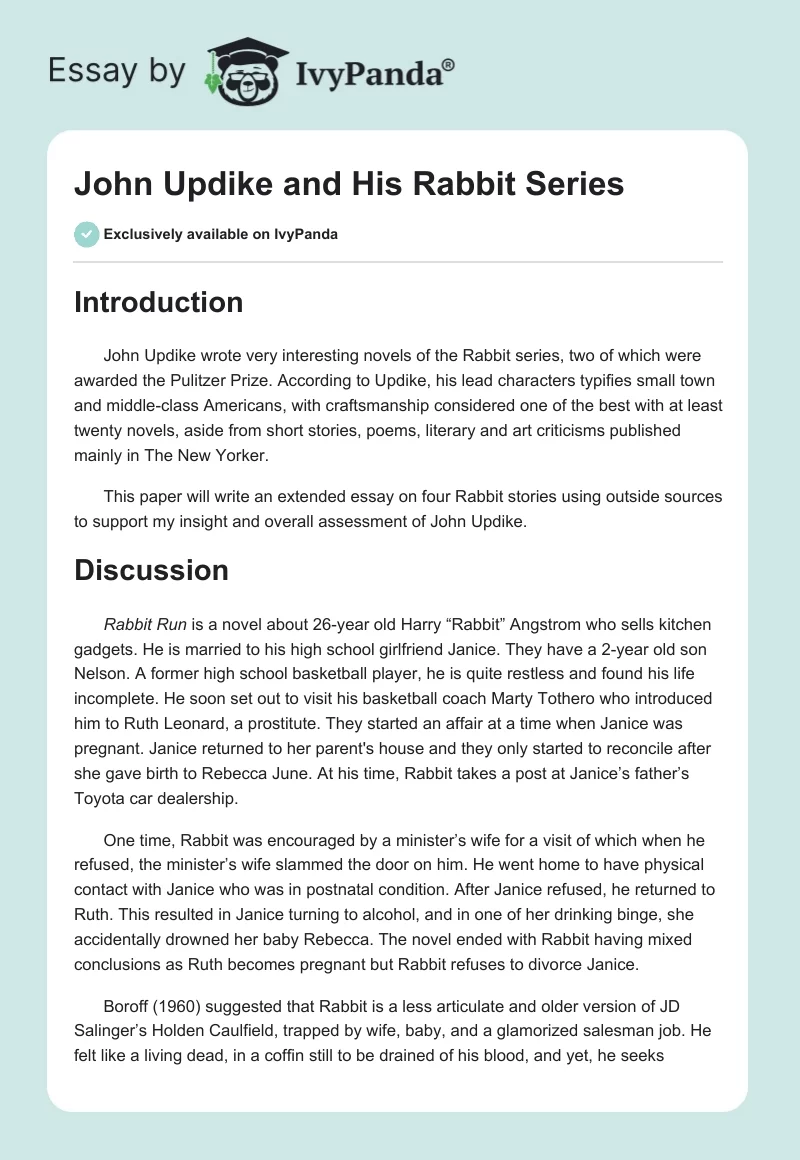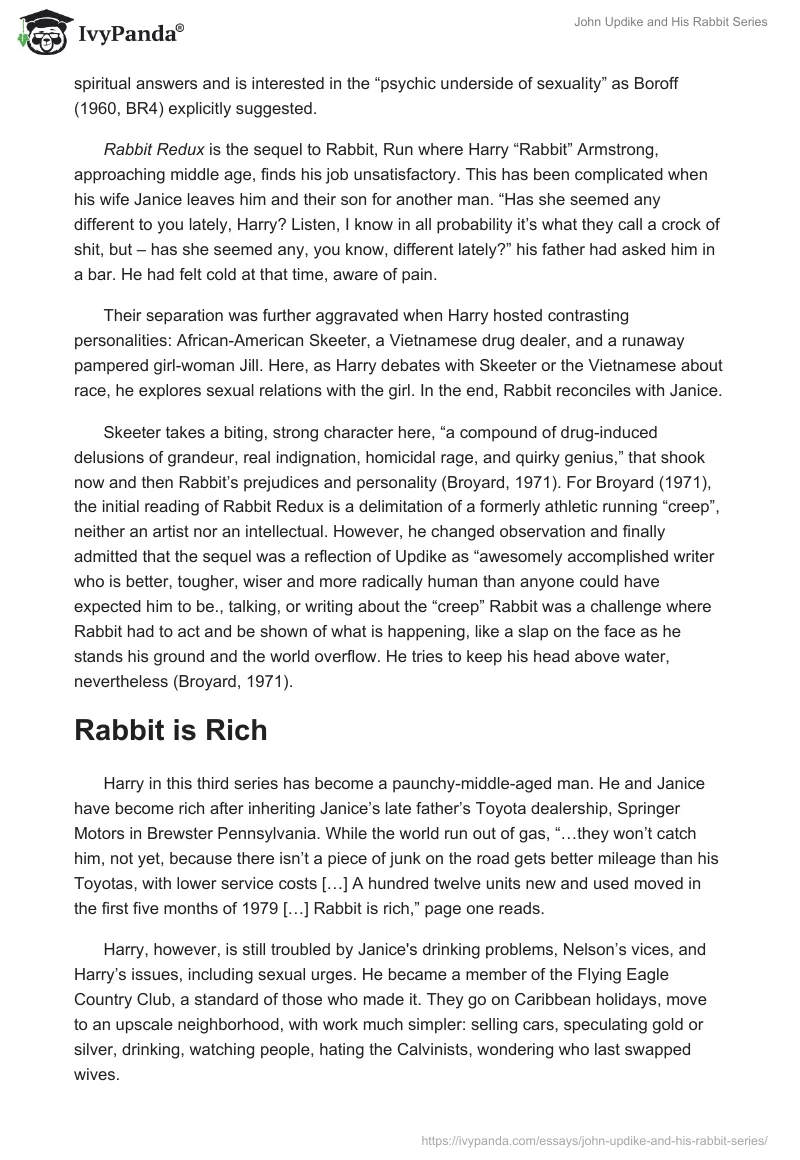Introduction
John Updike wrote very interesting novels of the Rabbit series, two of which were awarded the Pulitzer Prize. According to Updike, his lead characters typifies small town and middle-class Americans, with craftsmanship considered one of the best with at least twenty novels, aside from short stories, poems, literary and art criticisms published mainly in The New Yorker.
This paper will write an extended essay on four Rabbit stories using outside sources to support my insight and overall assessment of John Updike.
Discussion
Rabbit Run is a novel about 26-year old Harry “Rabbit” Angstrom who sells kitchen gadgets. He is married to his high school girlfriend Janice. They have a 2-year old son Nelson. A former high school basketball player, he is quite restless and found his life incomplete. He soon set out to visit his basketball coach Marty Tothero who introduced him to Ruth Leonard, a prostitute. They started an affair at a time when Janice was pregnant. Janice returned to her parent’s house and they only started to reconcile after she gave birth to Rebecca June. At his time, Rabbit takes a post at Janice’s father’s Toyota car dealership.
One time, Rabbit was encouraged by a minister’s wife for a visit of which when he refused, the minister’s wife slammed the door on him. He went home to have physical contact with Janice who was in postnatal condition. After Janice refused, he returned to Ruth. This resulted in Janice turning to alcohol, and in one of her drinking binge, she accidentally drowned her baby Rebecca. The novel ended with Rabbit having mixed conclusions as Ruth becomes pregnant but Rabbit refuses to divorce Janice.
Boroff (1960) suggested that Rabbit is a less articulate and older version of JD Salinger’s Holden Caulfield, trapped by wife, baby, and a glamorized salesman job. He felt like a living dead, in a coffin still to be drained of his blood, and yet, he seeks spiritual answers and is interested in the “psychic underside of sexuality” as Boroff (1960, BR4) explicitly suggested.
Rabbit Redux is the sequel to Rabbit, Run where Harry “Rabbit” Armstrong, approaching middle age, finds his job unsatisfactory. This has been complicated when his wife Janice leaves him and their son for another man. “Has she seemed any different to you lately, Harry? Listen, I know in all probability it’s what they call a crock of shit, but – has she seemed any, you know, different lately?” his father had asked him in a bar. He had felt cold at that time, aware of pain.
Their separation was further aggravated when Harry hosted contrasting personalities: African-American Skeeter, a Vietnamese drug dealer, and a runaway pampered girl-woman Jill. Here, as Harry debates with Skeeter or the Vietnamese about race, he explores sexual relations with the girl. In the end, Rabbit reconciles with Janice.
Skeeter takes a biting, strong character here, “a compound of drug-induced delusions of grandeur, real indignation, homicidal rage, and quirky genius,” that shook now and then Rabbit’s prejudices and personality (Broyard, 1971). For Broyard (1971), the initial reading of Rabbit Redux is a delimitation of a formerly athletic running “creep”, neither an artist nor an intellectual. However, he changed observation and finally admitted that the sequel was a reflection of Updike as “awesomely accomplished writer who is better, tougher, wiser and more radically human than anyone could have expected him to be., talking, or writing about the “creep” Rabbit was a challenge where Rabbit had to act and be shown of what is happening, like a slap on the face as he stands his ground and the world overflow. He tries to keep his head above water, nevertheless (Broyard, 1971).
Rabbit is Rich
Harry in this third series has become a paunchy-middle-aged man. He and Janice have become rich after inheriting Janice’s late father’s Toyota dealership, Springer Motors in Brewster Pennsylvania. While the world run out of gas, “…they won’t catch him, not yet, because there isn’t a piece of junk on the road gets better mileage than his Toyotas, with lower service costs […] A hundred twelve units new and used moved in the first five months of 1979 […] Rabbit is rich,” page one reads.
Harry, however, is still troubled by Janice’s drinking problems, Nelson’s vices, and Harry’s issues, including sexual urges. He became a member of the Flying Eagle Country Club, a standard of those who made it. They go on Caribbean holidays, move to an upscale neighborhood, with work much simpler: selling cars, speculating gold or silver, drinking, watching people, hating the Calvinists, wondering who last swapped wives.
Here, he searches for Ruth, no longer as a rebel seeking answers but to check on what happened, wondering if they had a child. Here, he also gets involved with Thelma, the wife of a country club friend.
Rabbit at Rest
This fourth of a series is considered as the most ambitious as Rabbit had been rich, on top of the heap. “Harry has flown in his life to dealer’s conferences here and there and that great time nine years ago with two other couples to the Caribbean,” (p 6) it was recalled in the first chapter of the book. They have moved to retirement capital Florida in the cold months. This time, overweight Harry is in dangerous health and had a heart attack. This is complicated by his drug-addict son Nelson, already married to Pru, with a nine-year-old daughter Judy, and in control of the Toyota dealership. A déjà vu occurred when Harry was able to rescue the drowning Judy at the beach, reminding followers of his infant Rebecca June who died through drowning.
After Nelson was rehabilitated, Janice works as a real estate agent. But the twist came after the family found out Harry had a one-night affair with Pru. Harry escaped and died while in hiding. Incidentally, his death came after a basketball game with a youth, a return to the Rabbit Run opening.
It was thought that Rabbit ends in this series, as he already died (Oates, 1990). The book’s theme is an exploration of getting ready, of death, of a body and spirit about to give up. It seemed everybody here is dying: Harry’s mistress Thelma from Rabbit is Rich, has lupus, an AIDS patient who crosses paths with Harry in Florida, and cocaine addict Nelson. For Oates (1990), “The being that most illuminates the Rabbit quartet is not finally Harry Angstrom himself but the world through which he moves in his slow downward slide, meticulously recorded by one of our most gifted American realists.”
Conclusion
Applying Updike’s literary criticism advice, to understand what the author wished to do, or to provide quotations when necessary, there is not much to say but flow with the success of the Rabbit books. He is one of America’s greatest fiction writers and influenced many more.
Updike’s themes prevalent in his Rabbit series are sex, religion, American society, and death, lived out by somewhat torn, a little mediocre, mid-American Harry Angstrom. Harry was always involved in an affair, at the same time seeking spiritual enlightenment. Harry is the same age as Updike, born circa the 1930s. Harry’s life and the novels mirrored American society, the trends, and crises, economic and personal. In the novels, contrasting views, as may be prevalent of the time, such as the Vietnam war in Rabbit Redux, the gas and car-frenzy problems in Rabbit is Rich, and the diseases of the west in Rabbit at Rest.
Harry Angstrom, unlike many protagonists, is but imperfect, shown and illustrated craftily by Updike with warts and all. And yet, Updike was able to provide substance is rather regular, ordinary citizens like Angstrom, with their regular associations. This is what made the Rabbit series, and Updike a celebrated author. Updike did not crop unwanted segments of photographs, of the pages of his books, to make them perfect frames that the viewer will appreciate. Instead, he presented realistic events and thoughts, so that the reader mirrors the self, thereby providing an insight into mundane thoughts and actions that although we may deny, actually matter. Updike wrote, “…n that room, where my only duty was to describe reality as it had become to me — to give the mundane its beautiful due,” in Introduction of his The Early Stories (2004).
Reference
Boroff, David. (1960) “You Cannot Flee.” ProQuest Historical Newspapers The New York Times (1851-2003) p BR4. Web.
Broyard, Anatole (1971). “Rabbit Redux: Review.” New York Times, 1971, Web.
Oates, Joyce Carol (1990). “So Young!: Book Review, Rabbit at Rest.” New York Times Books, 1990, Late Edition – Final Section 7; Page 1, Column 1; Web.
Updike, John (2004). The Early Stories (1953-1975). Ballantine Books.


